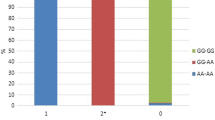Abstract
Single-nucleotide polymorphisms (SNPs) constitute an abundant source of DNA polymorphisms, which have been successfully used to identify loci that are associated with a particular phenotype. Additionally, such markers could be efficiently used in combination with doubled haploid technology to improve the efficiency of breeding programmes. Information on such markers in plants is still scarce. For bread wheat, SNP data are restricted to a few genes. This can be explained by the hexaploidy of Triticum aestivum which makes SNP discovery difficult. We developed a novel method for SNP discovery in bread wheat. The strategy is based on the development of highly specific PCR-primers, which were used to sequence 27 lines. SNPs were discovered from sequence alignment data. Some SNPs were identified by mass spectrometry in a collection of 113 lines, which were both evaluated for agronomic traits and genotyped at 42 neutral microsatellite loci. Traits investigated include: protein content, the quantity of high-molecular-weight glutenins and that of the GluBx subunit. The 42 markers were used to infer population structure, which was included in linear models for association studies. The results of this preliminary study showed 89 SNPs in approximately 20 kbp, i.e., one SNP every 223 bp on average. Six SNPs were genotyped: three were located along the sequence of Glu-B1-1, while three non-synonymous SNPs were located along the sequence of the B homoeologous gene coding for SPA (Storage Protein Activator). The SNPs from Glu-B1-1 had a significant effect on the studied variables, whereas those of SPA had no effect. Such results might indicate that some haplotypes for Glu-B1-1 are linked to higher protein content, through an increased amount of high-molecular-weight glutenins, especially the GluBx subunit.
Similar content being viewed by others
Abbreviations
- DH:
-
Doubled haploid
- HMWG:
-
High-molecular-weight glutenins
References
Albani D, Hammond-Kosack MCU, Smith C, Conlan S, Colot V et al (1997) The wheat transcriptional activator SPA: a seed-specific bZIP protein that recognizes the GCN4-like motif in the bifactorial endosperm box of prolamin genes. The Plant Cell 9:171–184
Chalhoub B, Allouis S, Safar J, Janda J, Bellec A et al (2003) Towards precise analysis of the wheat genome: preparation of genomic resources for structural and functional characterisation. In: Pogna NE, Romanò M, Pogna EA, Galterio G, (eds) The proceedings of the Xth international wheat genetics symposium. Paestum, Italy, pp 229–233
Giroux MJ, Morris CF, (1997) A glycine to serine change in puroindoline b is associated with wheat grain hardness and low levels of starch-surface friabilin. Theor Appl Genet 95:857–864
Guillaumie S, Charmet G, Linossier L, Torney V, Robert N et al (2004) Co-location between a gene encoding for the bZip factor SPA and an eQTL for a high-molecular-weight glutenin subunit in wheat (Triticum aestivum). Genome 47:705–713
Nordborg M, Borevitz JO, Bergelson J, Berry CC, Chory J et al (2002) The extend of linkage desequilibrium in Arabidospsis thaliana. Nat Genet 30:190–193
Pritchard JK, Stephens M, Donnelly P (2000) Inference of population structure using multilocus genotype data. Genetics 155:945–959
Remington DL, Thornberry JM, Matsuoka Y, Wilson LM, Whitt SR et al (2001) Structure of linkage desequilibrium and phenotypic associations in the maize genome. Proc Nat Acad Sci USA 98:11479–11484
Radovanovic N, Cloutier S (2003) Gene-assisted selection for high molecular weight glutenin subunits in wheat doubled haploid breeding programs. Mol Breed 12:51–59
Roussel V, Koenig J, Beckert M, Balfourier F (2004) Molecular diversity in French bread wheat accessions related to temporal trends and breeding programmes. Theor Appl Genet 108:920–930
Sauer S, Lechner D, Berlin K, Plancon C, Heuermann A et al (2000) Full flexibility genotyping of single nucleotide polymorphisms by the GOOD assay. Nucleic Acids Res 28:E100
Sears ER (1966) Nullisomic-tetrasomic combinations in hexaploid wheat. In: Riley R, Lewis KR, (eds) Chromosome manipulations and plant genetics. Olivier and Boyd, Edinburgh, pp 29–45
Tenaillon M, Sawkins MC, Long AD, Gaut RL, Doebley JF et al (2001) Patterns of DNA sequence polymorphism along chromosome 1 of maize (Zea mays ssp. mays L.). Proc Nat Acad Sci USA 98:9161–9166
Zhu YL, Song QJ, Hyten DL, Van Tassell CP, Matukumalli LK, Grimm DR, Hyatt SM, Fickus EW, Young ND, Cregan PB, (2003) Single-Nucleotide Polymorphism in soybean. Genetics 163:1123–1134
Acknowledgements
This research was funded by the French federative genomic program génoplante.
Author information
Authors and Affiliations
Corresponding author
Rights and permissions
About this article
Cite this article
Ravel, C., Praud, S., Canaguier, A. et al. DNA sequence polymorphisms and their application to bread wheat quality. Euphytica 158, 331–336 (2007). https://doi.org/10.1007/s10681-006-9288-z
Received:
Accepted:
Published:
Issue Date:
DOI: https://doi.org/10.1007/s10681-006-9288-z




